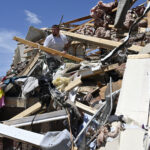Pam Howard was lucky to get antibiotics after last month’s floodwaters slammed her into a barbed wire fence as she rescued a pony.
Cuts on her hands — she grabbed metal spikes as the Chehalis River tried to sweep her under — got infected from the contaminated soup.
The river picked up every kind of pollution on its riotous run. That’s why Howard now carefully separates mud scooped from the garage, where her family stored paint, oil and aerosol cans.
“If we all just threw this stuff around, what would we end up with? We’d get potatoes with arms and legs,” she said. “It’s a pain … but you have to be responsible.”
Still, it’s a struggle some days not to walk away from her once-perfect white farmhouse built just two years ago.
Seven weeks into a recovery that is expected to take months — if not years — the picture that’s emerging of environmental, physical and psychological damage in Southwest Washington is mixed.
Drinking water from wells in some areas remains contaminated with E. coli and other bacteria. A small water system with obliterated lines may need more than $1 million worth of repairs.
Mold — a health threat that also rots houses — is a huge concern. Yet private donations that had been paying for dehumidifiers, drywall and other rebuilding supplies ran out last week.
“The money’s going to run out sometime for the motels. The graciousness of friends and relatives are going to run out, and where are these people going to go?” asked Ross McDowell, Lewis County’s deputy director of emergency management.
Next week, state environmental officials will launch a push to collect hazardous materials that washed up in fields and lodged in logjams that are measured in acres. That includes everything from oil drums to corn defoliators to lights containing mercury.
So far, though, public health officials say repeated entreaties to wash hands, test wells and wear protective clothes when working in floodwaters seem to have paid off. Local hospitals — which expected an increase in gastrointestinal and respiratory illnesses after the floods — haven’t treated patients in unusual numbers.
Animals haven’t been as fortunate. Cows that survived the floods but stood in bacteria-laden water have udder infections. Dogs that drank from puddles got sick.
Though floods can benefit fish habitat in the long run, they also wiped out this year’s salmon redds and eggs. That will depress a popular sport fishery in future years.
With 1,300 damaged houses in Lewis County alone, building inspectors are caught between getting families back into their homes as quickly as possible and ensuring they’re dry enough to be safe.
Farm communities upstream of Chehalis didn’t wait for government help. Doty residents passed the hat, raised thousands of dollars, bought their own drying equipment and organized volunteers to cook soup and pies for drywall installers.
Some homeowners, though, are light-years ahead of others.
One living room in the Boistfort Valley this week — stripped of everything except studs, pipes and a ceiling fan that once was underwater — still looked like a mud-wrestling ring.
On Friday, Gov. Chris Gregoire visited that hard-hit rural area, saying residents still need outside help in cash donations and volunteers.
“The biggest challenge to the folks in Lewis County is really their mental health,” said Diana Yu, the former top health officer for the county of 74,000 people.
“Where people didn’t have much before, they have nothing now, and to reel back from that is going to be a humongous challenge. But on the other hand, folks down there are just awesome and very resilient.”
‘Probably nasty’
Along the banks of the Chehalis River, it looks like someone took a paring knife to the road, cut it into strips, and tossed them into neighboring farm fields. The floodwaters twisted chain-link fences into octopus shapes.
Here, Ron Holcomb finds an old drum from a spearmint processor, which recently could have stored anything. Nearby, a Texaco drum that washed up is split open like a zipper.
State officials are asking flood victims to let them know about any potentially hazardous flotsam this week. They’ve removed more than 170 containers from roadways, and are eager to properly dispose of those on private property.
“The ones that are still there — particularly with something in them — we want to get them out to protect the public because some of this stuff is probably nasty,” said Holcomb, an Ecology Department hazardous-materials specialist.
Nearby, the scene resembled a garage exploding in a forest. In one small logjam, they found motor oil, equine shampoo, pesticides, antifreeze, degreasers, coolers and playground slides.
State spill responders don chemical suits, respirators and lavender gloves to test unknown liquids. The spearmint drum, it turns out, is filled with muddy water.
It’s impossible to know how much pollution found its way into the floodwater. But public health experts say that unless there was a concentrated spill, it should have been diluted enough to pose little threat to residents or cleanup volunteers.
Practicing basic hygiene and making sure nothing drips on your sandwich should be enough, they say. But it’s not foolproof, as one county health specialist discovered when his stomach revolted after days of overseeing the removal of dead animals.
“If you think about a flood and the sheer volume of water and how much of that is manure and how much gets into your mouth … the volume and dilution generally protect us,” said Marcia Goldoft, acting state epidemiologist for communicable diseases.
Contaminated drinking water, however, is a bigger threat.
In Lewis County, 41 percent of private well tests have come back positive for total coliform bacteria, an indicator species that suggests other pollution may be present. Fourteen percent have detected E. coli, though not necessarily the virulent strain.
Individual wells aren’t regulated. But county health officials are working with landowners to disinfect wells and pipes, a relatively simple procedure that can be done with bleach. Meanwhile, bottled water is available at area command centers.
In older, shallow, hand-dug wells, though, bacterial contamination can be a fact of life. Longtime homeowners may have developed a tolerance, officials say.
‘I will get it back’
That hardiness is abundantly evident in the Boistfort Valley. Steve Roberts’ 64-year-old father originally refused to accept any food donated to the local Baw Faw Grange.
“He said, ‘We’re not that type of people.’ I said, ‘We are that type now,'” said Roberts, 43, who owns a lawn mower shop.
A bare birch tree in his front yard protrudes from an expanse of coffee-colored, ankle-swallowing mud. “I will get it back,” he says, of the grass he used to manicure.
Younger men disappear through a hole in the floor of his house, slither through filthy, hypothermia-inducing sludge and rip out insulation.
Rotating volunteer crews have battled the relentless mud for weeks.
“You’d dig … and there would be the family Bible — there was no way you could save it,” said Norm Baird, mucking out a garage. “You get the kitchen floor clean and five minutes later it would have oozed out of the cabinets.”
Building inspectors test moisture content in studs before homeowners are allowed to put back insulation and drywall.
Repairs have to wait until homes are dry enough that mold or algae won’t take root. Even then, there are no guarantees, said county building official and fire marshal Fred Chapman.
But with private donations exhausted, Lewis County emergency officials had to pull 40 dehumidifiers and fans out of the field last week. They cost $10,000 a week to rent.
Chapman estimates at least 135 homes in unincorporated areas will have to be demolished. More than half of the severely damaged homes weren’t in any mapped floodplain, he said, and FEMA grants of $28,800 only begin to cover some losses.
In a handful of cases, social workers have taken custody of children when their parents ignored warnings and moved back into condemned homes, he said.
But everyone understands there’s a balance between making sure people are protected and the psychological benefits of being back in their houses, Chapman said.
“The sooner they can be in their own warm, dry bed the better for everybody,” he said. “Honestly, a lot of the stuff we’re letting people utilize because there’s an incredible shortage of housing here. It’s not like there’s 1,500 empty houses right now.”
Was this article valuable?
Here are more articles you may enjoy.

 Central US Severe Weather Outbreak Caused Billions in Damages, AccuWeather Says
Central US Severe Weather Outbreak Caused Billions in Damages, AccuWeather Says  Brazil Sues EV Giant BYD Over ‘Slavery’ Conditions at Plant
Brazil Sues EV Giant BYD Over ‘Slavery’ Conditions at Plant  Report Shows Cargo Theft Risk at All-Time Highs as Memorial Day Weekend Nears
Report Shows Cargo Theft Risk at All-Time Highs as Memorial Day Weekend Nears  Plane Crashes into San Diego Neighborhood, Setting Homes And Vehicles on Fire
Plane Crashes into San Diego Neighborhood, Setting Homes And Vehicles on Fire 